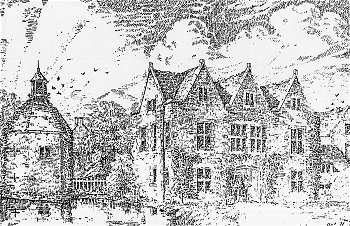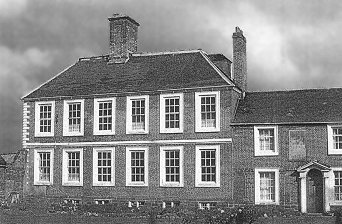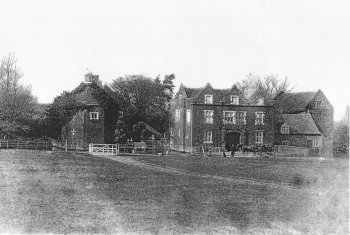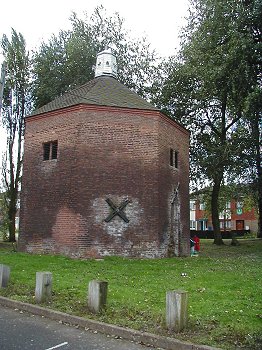|
Barnhurst
The
name may refer to a tithe barn, belonging to the Canons of
Tettenhall Collegiate Church, which was located here or may mean
woodland cleared by burning.
An
estate here was held by the canons of Tettenhall in the late
thirteenth century.
Barnhurst became a family name and several members were
mentioned in deeds and charters of the fourteenth and fifteenth
centuries. A path between Barnhurst and Cronkhall Green (where
Windermere Road now stands) was mentioned in 1419.
In
1521, Joan Milston, daughter and heir of a John Barnhurst sold
the manor which consisted of a house and 70 acres of land, to
James Leveson of Wolverhampton.
By the time of his death in 1547 he had more than doubled
his holdings at Barnhurst.
Barnhurst field, first mentioned in the early sixteenth
century, had been enclosed by 1613.
|
|

Barnhurst Farm and Dovecote. From an old
engraving.
|
The
farm later passed to the Cresswell family,
several of
whom are described as merchants of the staple.
This means that they were wool merchants at a time when
Wolverhampton was an important centre of the trade.
In the 1720's the estate was sold to Samuel Hellier of
the Wodehouse in Wombourne and the new owners continued the
expansion of the property.
Three houses were noted at Barnhurst in 1780.
|
| In 1867
Wolverhampton Corporation bought the Barnhurst estate and Little
Barnhurst, in total covering about 300 acres, from Thomas
Shaw-Hellier, for £27,915.
Part of the land was
developed as a sewerage farm which was in operation by 1870.
An aqueduct crosses the canal south of Oxley Moor Bridge,
bringing Wolverhampton's untreated sewage to Barnhurst and a
barely decipherable foundation stone reads :
WOLVERHAMPTON MAIN DRAINAGE
THIS STONE WAS LAID BY
ALDERMAN HAWKSFORD
JULY 3RD 1868
ALDERMAN J.LANGMAN, MAYOR
A.MORGAN, ENGINEER
G.FORD,
CONTRACTOR.
Unfortunately the first sewage aqueduct collapsed two years
later. It was soon rebuilt and has continued its necessary task ever
since. A new
aqueduct was built and opened in 2001.
|
|
The
whole of the sewerage of the borough was concentrated in
settling pits which were from time to time emptied onto the
land. In 1872 there
was a court case involving the Borough and landowners along
Pendeford Brook who complained about an almost continual
overflow from the settling pits finding its way into the brook.
The narrow channel could not cope and sewage overflowed
onto the land causing considerable damage and possible nuisance.
|

Barnhurst farmhouse in the early 1960s. |
| A basin
was built in 1888 on the Staffs & Worcs Canal and the entire
works were rebuilt and improved.
Boats delivered lime for the settling tanks and coal for
the boilers of steam pumps and carried away pressed sludge
"cake" for use on farms.
A light railway system operated in conjunction with the
wharf until 1913 when the sludge pressing plant closed.
The basin is now the outfall for about two million litres
of treated effluent per day.
|
|

Another view of the farm buildings. |
By 1925 the
flow of sewage into the works approached 4 million gallons a day
and a new system of treating it was called for.
Two years later the activated sludge process was
introduced, with biological filters, and the first bio-aeration
plant in the world was set up. It was envisaged that the new plant would deal with all the
sewerage, but with the opening of Courtaulds the nature of the
sewerage changed. |
| In 1928
the system of pumping onto farmland was abandoned and biological
filters were used for all sewerage.
The cleaned effluent was pumped into Pendeford Brook.
|
| After the
Second World War, there was a movement of population from the
town and so the domestic flow reduced.
Industrial wastes more than made up for this decline and
were much harder to treat.
The corporation was in trouble in 1956, for polluting
Pendeford Brook and later for polluting the Shropshire Union
Canal. Major
reconstruction took place in 1962 which increased the plant's
capacity by 50% and again in 1970 when capacity was doubled.
The rest of the Barnhurst land was farmed by Wolverhampton
corporation until 1975 by which time other plans were afoot.
The last Barnhurst
Farm was built in 1963, replacing an earlier moated house which
was demolished.
There was also a brick gatehouse with three bays, built
in 1602 and demolished in 1961.
The large octagonal brick dovecote, dating back to the
sixteenth or seventeenth century still remains and has given its
name to the surrounding housing development.
|

The dovecote as it is today. |
|
Many
farms possessed a dovecote to ensure a supply of fresh meat.
The building contained spaces for roosting and the
pigeons and doves had free access.
A
public enquiry was held in 1980 - '81 resulting in the saving of
the Grade II listed building.
As a result of work by the Dovecote Project, a group led
by the Dovecotes Tenants and Residents Association with
Wolverhampton City Council, a £36,000 grant from the Heritage
Lottery Fund was announced in March, 2003 to develop the
building as a community educational facility.
The
Dovecote is not the only tangible reminder of the ancient
Barnhurst. The present writer has a memory of visiting the farm,
sometime in the mid 1970's, to rescue cast iron window frames
from some of the buildings for re-use at the then recently
conceived Black Country Museum.
Other reminders of Barnhurst's agricultural past are in the
street names chosen for the Dovecotes development as well as the
public house of the same name.
Outside the latter stands a triple furrow plough once used on
farmland in the Barnhurst area.
The railway line, which forms Dovecote's present
southern boundary, was opened in 1849 as the Wolverhampton -
Shrewsbury Railway.
It later became part of the Great Western Railway system.
|

|
|

|
|

|
Return to
The Canals |
|
Return to
the contents |
|
Proceed to
Miscellany |
|